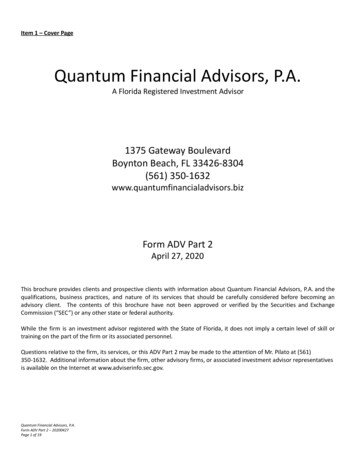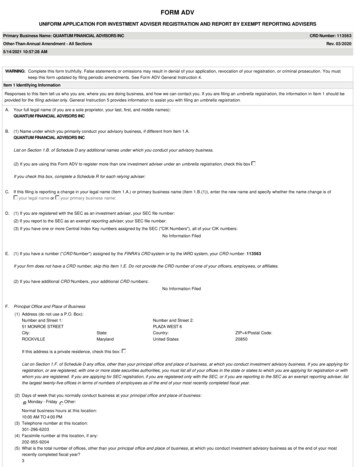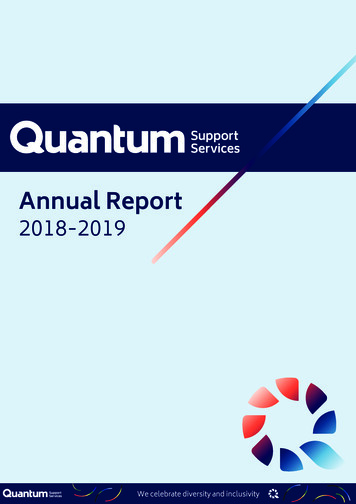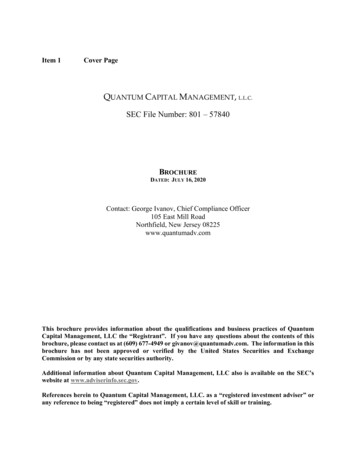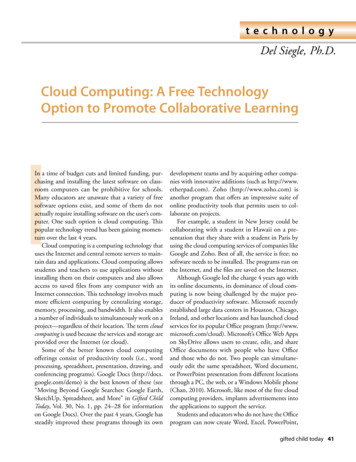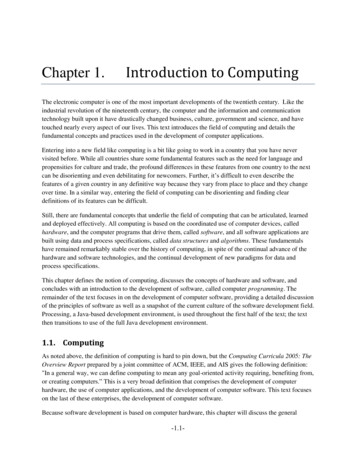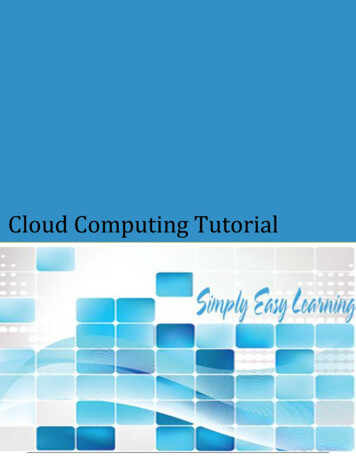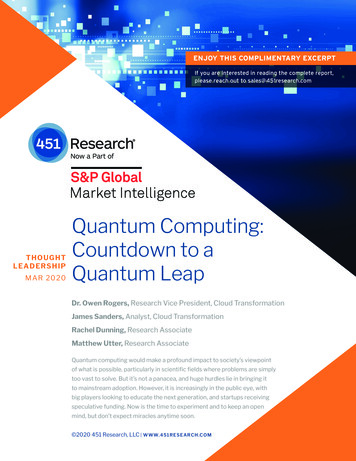
Transcription
ENJOY THIS COMPLIMENTARY EXCERPTIf you are interested in reading the complete report,please reach out to sales@451research.comTHOUGHTLEADE R S H I PMAR 2020Quantum Computing:Countdown to aQuantum LeapDr. Owen Rogers, Research Vice President, Cloud TransformationJames Sanders, Analyst, Cloud TransformationRachel Dunning, Research AssociateMatthew Utter, Research AssociateQuantum computing would make a profound impact to society’s viewpointof what is possible, particularly in scientific fields where problems are simplytoo vast to solve. But it’s not a panacea, and huge hurdles lie in bringing itto mainstream adoption. However, it is increasingly in the public eye, withbig players looking to educate the next generation, and startups receivingspeculative funding. Now is the time to experiment and to keep an openmind, but don’t expect miracles anytime soon. 2020 451 Research, LLC W W W.4 51RE SE A RCH.CO M
REPORT EXCERPTAbout the AuthorsDr. Owen RogersResearch Vice President, Cloud TransformationAs Research Vice President, Owen Rogers leads the firm’s Digital EconomicsUnit, which serves to help customers understand the economics behind digitaland cloud technologies so they can make informed choices when costing andpricing their own products and services, as well as those from their vendors,suppliers and competitors. Owen is the architect of the Cloud Price Index, 451Research’s benchmark indicator of the costs of public, private and managedclouds, and the Cloud Price Codex, our global survey of cloud pricing methodsand mechanisms. Owen is also head of 451 Research’s Center of Excellencefor Quantum Technologies. Owen has previously held product managementpositions at Cable & Wireless and Claranet, and has developed a number ofhosting and cloud services. He is a Chartered Engineer, a Member of the BritishComputer Society and a member of the Royal Economic Society. In 2013,he completed his PhD thesis on the economics of cloud computing at theUniversity of Bristol. Owen was named ‘Innovative Analyst of the Year’ in theInstitute of Industry Analyst Relations’ global awards in 2018.James SandersRachel DunningAnalyst, Cloud TransformationResearch AssociateMatthew UtterResearch AssociateQuantum Computing: Countdown to a Quantum Leap C O P Y R I G H T 2 0 2 0 4 5 1 R E S E A R C H . A L L R I G H T S R E S E R V E D.
REPORT EXCERPTKey Findings Quantum computing will have profound impact on technology and even society if (and weemphasize if) it becomes mainstream. However, there are still huge hurdles to overcome.We think we are at least a decade away from quantum computing solving a problem that iscurrently unsolvable in useful timeframes using a traditional computer. A quantum computer allows all states to encoded in the uncertainty of the characteristics of asubatomic particle and then evaluated once, as opposed to a traditional computer where eachstate must be encoded and evaluated separately. Many problems that would take too long tosolve today (measured in thousands of years) could be solved in a matter of minutes or hours.The challenge is in getting such small particles under control, and preventing tiny interactionscorrupting the data we are trying to process. Investments from the likes of IBM, Microsoft, Google, Amazon and Honeywell are unlikely tohave made a financial return yet, but if quantum computing becomes mainstream, the returnswill be significant. Quantum computing vendors are informing and educating the next generation for whenquantum computing is commercially viable. Vendors hope this gives them the ability tocapitalize when the technology becomes mainstream. The fundamental use case of quantum computing is to solve problems with so manypermutations that they can’t be processed in human timeframes. We believe the key use caseswill be scientific (chemical engineering, physics, biochemistry, healthcare, materials engineeringand mathematics), where there is a need to compute and resolve a vast quantity of states. Quantum computers should be thought of as an entrant in the class of compute acceleratorsthat provide specific capability in a hybrid model alongside general-purpose processors.Increase in adoption and reduction of the costs of FPGAs, ASICs and GPUs may makequantum computing’s economic argument less clear cut. Although cracking keys is often cited as a use case, new quantum-proof algorithms,technologies, and even simply increasing key lengths in some cases can effectively mitigatethis threat today and in the longer term. Our recommendation is that companies with even a slight interest should free up one of theirdevelopers to experiment for a few hours a week, just so they are better placed to identifyquantum computing opportunities. Those that already have a problem in mind thatpromises a big return should test the waters with quantum computing vendors.Quantum Computing: Countdown to a Quantum Leap C O P Y R I G H T 2 0 2 0 4 5 1 R E S E A R C H . A L L R I G H T S R E S E R V E D.
REPORT EXCERPTExecutive SummaryIntroductionQuantum computing has been the subject of research since the early 1980s, and – theoretically– there is a huge basis to believe that the use of particles of unimaginable smallness could unlockproblems that have been out of reach in realistic timeframes using traditional computing models.However, there are massive practical challenges in controlling these tiny particles for longQuantum enough to actually make them do what we want. Simply put, there are no guarantees that we cancomputing is a use them to solve practical problems.gamble and thereare no guarantees, Yet the business case is strong – a practical quantum computer would open the door tobut for such a incredible opportunities in physics, chemistry, machine learning, finance, healthcare and beyond.huge payoff, it is While no panacea, viable quantum computing would increase our ability to attack previouslyprobably a risk insurmountable computational challenges, from the structure of materials to the folding ofworth taking. proteins to nature’s ability to produce chemical reactions, which would be impractically timeconsuming or impossible even with the deterministic computers we all use today.We are still years away from creating such value with quantum systems, if it’s at all possible.But it’s telling that those investigating quantum computing are speaking up more andmore. IBM, Google, Microsoft, AWS, Honeywell and other established players are makingbig announcements, even squabbling over relative progress. Startups are being funded toinvestigate technologies and even software development. Quantum computing is a gamble andthere are no guarantees, but for such a huge payoff, it is probably a risk worth taking.This report takes a look at the current state of quantum computing for a general audience.Quantum computing is a highly mathematical discipline and, unfortunately, our grasp of commonsense in the macroworld we live in breaks down in the microworld. Our advice is to suspendpreconceptions of what is possible and just accept that at such tiny distances, experiencesand potentialities are different. The ‘Theory of Everything,’ which aims to reconcile physics atthe macroworld and microworld level, shows this is a problem that isn’t just baffling for normalpeople, but for physicists too. Our aim is to enable a technology- or business-focused reader togain a general understanding of the concepts.This report relies on analogies to simplify the complexities and minutiae of quantum computing.Our representation of quantum computing is practical and utilitarian, intended as a fundamentalprimer for technology leaders to understand the opportunities and market. By its very definition,the ‘state of the art‘ of quantum computing is constantly iterating and evolving, though forpresent state, most industries should wait attentively for the right moment to invest capital.Quantum Computing: Countdown to a Quantum Leap C O P Y R I G H T 2 0 2 0 4 5 1 R E S E A R C H . A L L R I G H T S R E S E R V E D.
REPORT EXCERPTPresently, we strongly encourage investing time. Experimentation in quantum computing – ifeven just a side project from a single developer interested in exploring frameworks and cloudbased quantum computers detailed in this report – can open the mind to future opportunitiesand potentialities when (if) quantum computing becomes mainstream. Allowing developertime to be spent now can provide an early – if small – advantage, at a tiny cost. Enterprises witha specific problem in mind have nothing to lose (and potentially much to gain longer term) byengaging vendors now.The great physicist Richard Feynman said, “If you think you understand quantum mechanics, youdon’t understand quantum mechanics.” Don’t try to get all the details today, just open your mindto the possibilities.MethodologyFollowing the launch of our Quantum Computing Centre of Excellence in 2019, the 451 ResearchAssociate team set about collecting data from websites on companies working on quantumcomputing, be it as vendors selling hardware, providers offering quantum services, enterprisesrunning proofs of concept, or startups dabbling in development. From this extensive list, 451Research focused on companies selling or developing groundbreaking quantum technology andorganized briefings supplemented with further investigation from public sources. The aim of thisreport is not to rank what is a very emerging market, but to show the current state of the art andeducate business leaders on its potential impact.Reports such as this one represents a holistic perspective on key emerging markets in theenterprise IT space. These markets evolve quickly, though, so 451 Research offers additionalservices that provide critical marketplace updates. These updated reports and perspectivesare presented on a daily basis via the company’s core intelligence service, 451 Research MarketInsight. Forward-looking M&A analysis and perspectives on strategic acquisitions and theliquidity environment for technology companies are also updated regularly via Market Insight,which is backed by the industry-leading 451 Research M&A KnowledgeBase.Emerging technologies and markets are covered in 451 Research channels including AppliedInfrastructure & DevOps; Cloud & Managed Services Transformation; Customer Experience &Commerce; Data, AI & Analytics; Datacenter Services & Infrastructure; Information Security;Internet of Things; and Workforce Productivity & Collaboration.Beyond that, 451 Research has a robust set of quantitative insights covered in products suchas Voice of the Enterprise, Voice of the Connected User Landscape, Voice of the ServiceProvider, Cloud Price Index, Market Monitor, the M&A KnowledgeBase and the DatacenterKnowledgeBase.All of these 451 Research services, which are accessible via the web, provide critical and timelyanalysis specifically focused on the business of enterprise IT innovation.For more information about 451 Research, please go to: www.451research.com.Quantum Computing: Countdown to a Quantum Leap C O P Y R I G H T 2 0 2 0 4 5 1 R E S E A R C H . A L L R I G H T S R E S E R V E D.
REPORT EXCERPTTable of Contents1. Introduction to Quantum Computing 1Schrödinger’s Cat 1The Quantum Treasure Chest 1Figure 1: Brute-Force Problem-Solving Approach 2Figure 2: Quantum Problem-Solving Approach 3Getting Down to Qubits 4Quantum Gates: The Standard Universal Computer Architecture 5Quantum Annealing: A Specific Architecture for Specific Problems 62. Success Factors 7Benchmark Use Cases 7Figure 3: Most Overhyped Security Buzzwords 7Role of Economics 8Figure 4: A Minority of Providers Are Considering Quantum Computing 10Measuring Success 103. Types of Qubit 13Superconducting 13Trapped Ion 13Spin Qubits/Quantum Dots 14Topological 144. Hardware Is the Battleground 15IBM 16D-Wave 17Rigetti Computing 18Honeywell 19IonQ 19Quantum Circuits, Inc 20Quantum Computing: Countdown to a Quantum Leap C O P Y R I G H T 2 0 2 0 4 5 1 R E S E A R C H . A L L R I G H T S R E S E R V E D.
REPORT EXCERPT5. Development and Services Open the Door 21Qiskit 21Q# 22Amazon Braket 22Azure Quantum 231QBit 236. Big Tech Companies Research in the Background 24Microsoft 24Amazon 24Google 24Intel 257. The Post-Quantum Era 26Security Threat 26Quantum Key Distribution 278. Recommendations 309. Further Reading 31Appendix A – Companies Primarily Developing Quantum Computing Hardwareand/or Systems 32Appendix B – Companies/Projects Primarily Focusing on Quantum ComputingSoftware Development 39General 39Vertical-Specific 44Quantum Computing: Countdown to a Quantum Leap C O P Y R I G H T 2 0 2 0 4 5 1 R E S E A R C H . A L L R I G H T S R E S E R V E D.
REPORT EXCERPT1. Introduction toQuantum ComputingSchrödinger’s CatConsider a thought experiment involving a cat – Schrödinger’s cat. The cat is placed in a box,along with a radioactive material. When a sensor detects the radioactive material has radiated aparticle, a device releases toxic gas into the box, killing the poor cat. We put the cat into the boxalive, close the lid and wait. Is the cat alive or dead?There is no way of knowing unless we measure the cat’s state. We could open the box,acoustically listen for movements or x-ray the box. But these are all measurements, and wegenuinely have no way of knowing if the cat is alive or dead unless we penetrate the box usingsuch measurements. We can determine the probability of the cat being alive or dead after acertain time, but we can never be certain. Even if we knew everything about the state of theradioactive element before the cat goes in, we would not be able to know for sure when thefatal radioactive particle is released – in other words, the atomic and subatomic particles thatdetermine when a radioactive particle is released have inherent unpredictability. In essence, untilwe measure, the cat is both alive and dead, in a state of what is called superposition.At the subatomic level, this is actually the case – some particles don’t necessarily have anabsolute state, which prompted Einstein’s famous quote, “God does not play dice.” He couldn’taccept that some things are just inherently unpredictable. Even if we have all the data there is,we cannot determine what will come next. In the vacuum of space, particles can appear out ofnowhere and disappear within millionths of a second because of this inherent unpredictability. Itis this superposition of all possibilities due to inherent uncertainty that gives quantum computingits potential.The Quantum Treasure ChestImagine we have an impenetrable chest, in which lies a treasure of vast importance – perhapsa cure for cancer, or the key to nuclear fusion. To access the chest, we must find the correctthree-number combination of the padlock. If we don’t know the combination, the only way toaccess the chest is to try every possible combination from 000 to 999. But our chest is milesunderground, and not easily accessible. In fact, to test every single combination, it takes a wholeyear of planning and implementation. In the worst case, if the code were 999, we’d have to wait1,000 years to access the secrets inside (see Figure 1).Quantum Computing: Countdown to a Quantum Leap C O P Y R I G H T 2 0 2 0 4 5 1 R E S E A R C H . A L L R I G H T S R E S E R V E D.
REPORT EXCERPTFigure 1: Brute-Force Problem-Solving ApproachSource: 451 Research, 2020598 YEARS1 YEAR0 0000260 100 11 YEARSUCCESSBuilding a business case for investing in opening the chest is not feasible. Who would make aninvestment now for a return in – potentially – a thousand years? The payback period simply isn’tworth the effort.But imagine we have a magic box – Schrödinger’s box. The box is special because it can makevirtual ‘copies’ of the chest padlock, which represents inherent uncertainty. When we put thepadlock in the box, 1,000 copies of the padlock are made – not real copies that we can access, butvirtual padlocks encoded in the uncertainty of tiny particles. Now imagine we can manipulate thebox: fire lasers at it or expose it to magnetic fields such that we can simultaneously manipulateall these copies, without actually opening the box or examining the inside. In our scenario, wecould perhaps manipulate the combinations of the padlocks, such that each virtual padlock has adifferent code. This is akin to a quantum algorithm or ‘circuit.’ If we correctly manipulate the box,when we open it, these virtual copies disappear and all we see is the single padlock with the correctcombination (see Figure 2). If we keep opening and closing the box and sample the results, we canbecome increasingly confident that the combination is the correct result.Quantum Computing: Countdown to a Quantum Leap C O P Y R I G H T 2 0 2 0 4 5 1 R E S E A R C H . A L L R I G H T S R E S E R V E D.
REPORT EXCERPTFigure 2: Quantum Problem-Solving ApproachSource: 451 Research, 2020MANIPULATIONS1 YEAR0 0039899960 100 1?60 1SUCCESSThe crucial point about the box is we don’t have to test every combination. The box takesadvantage of the uncertainty of the position and movement of subatomic particles to test everycombination for us. So rather than having to do 1,000 tests, each taking a year, we can do a singletest that simultaneously looks at all combinations. The speed-up here is effectively from 1,000years to 1 year – is it worth investing in opening the padlock to cure cancer? Yes, it is likely thisinvestment would make a significant return.This is the quantum computer. In a nutshell, a quantum computer allows us to exploit uncertaintyin the characteristics of a subatomic particle by performing operations on this uncertainty. Oncethese operations are performed, the characteristics of the particle can be measured, and a resultobtained. The key part to remember is that a quantum computer allows all states to encodedin this uncertainty and then evaluated once, as opposed to a traditional computer where eachstate must be encoded and evaluated separately. This provides a huge (in fact, exponential)improvement in the time required to solve a problem.Quantum Computing: Countdown to a Quantum Leap C O P Y R I G H T 2 0 2 0 4 5 1 R E S E A R C H . A L L R I G H T S R E S E R V E D.
REPORT EXCERPTWhen the numbers get bigger, so too does the benefit of quantum computing. If the combinationlock is eight digits, it would take us 9,999,999 years to brute force every combination. In thequantum computer ‘box,’ it would take a year. But the problem is the box has to be able to handleso many combinations. This is the challenge facing quantum computing – making it powerfulenough to solve bigger combinations such that it provides a return on the investment.Getting Down to QubitsIn computing, binary digits (or bits) are used to represent data: 0 or 1. In quantum computing, qubitsare used, and these can represent 0, 1 or a superposition of 0 and 1. Until a qubit is measured, itis both 0 and 1, just like our cat is both alive and dead. It is this superposition that gives quantumcomputing an advantage over traditional computing (or Turing machines, more technically).If we have to store the state of all three-bit numbers in a register to be processed, then we needto store and process all successive states: [000,001,010, etc., to 111], which in decimal represents[0,1,2.7] on traditional computers – essentially, we have to store all of them in the same way wehave to look through all the padlock combinations, and then process each one individually. Thesame situation for three qubits is simply [?], with ‘?’ representing a superposition of both 0 and 1(i.e., hidden in the box with its state unknown). We put the unknown [?] in the box so that the boxmakes virtual copies of all the possible combinations from [000] to [111], and then manipulate thebox to solve our problem. When we open the box, the [?] becomes a definite answer.If we are trying to hack security keys, for example, rather than going through every possiblebit combination using a Turing machine, we can simply determine it once from the superposedqubits. We just need to manipulate the box in the right way (akin to an algorithm).A qubit is physically a subatomic particle, perhaps a photon (a packet of light) or an electron (thebasis of electricity). In the case of an electron, angular momentum, or ‘spin,’ is typically used todifferentiate between 0 and 1, typically ‘up’ spin and ‘down’ spin. In most Turing computers today,five volts represents 1, and 0 volts represents 0; there is no ambiguity between these states. Inquantum computing, we don’t know if the electron has up or down spin until it is measured, thusit has the ability to be in both states at the same time. This isn’t a trick – it is impossible to knowits exact state, and thus it represents all states. Crucially, we can affect the characteristics of theparticle without having to measure its state through microwave radiation or lasers or magneticfields. The qubits allow us to store all possibilities in a single register. Quantum ‘gates’ allow us tochange the characteristics of these particles, without us having to measure them directly, whichmeans the gates can perform operations on all possibilities at once. Many gates together make a‘circuit’ or algorithm.This physical basis of quantum computing is less important to understanding its potential than isits theoretic basis.Quantum Computing: Countdown to a Quantum Leap C O P Y R I G H T 2 0 2 0 4 5 1 R E S E A R C H . A L L R I G H T S R E S E R V E D.
REPORT EXCERPTLet’s say we are solving for the factors of a number (what numbers divide leaving no remainder)– for example, 10. Using a Turing machine, one way of finding factors is to continually dividethe number to see if it divides with no remainders – does nine fit? No. Does eight fit? No. Doesfive fit? Yes. So, it is a factor. etc. This is a computational challenge because for each numberwe are evaluating, we have to cycle through many other numbers to process. Using a quantumcomputer that has been superposed with all possible states, we can essentially run functions onall possibilities using these gates and determine the output all at once. It’s akin to working witha single row on an Excel spreadsheet compared with a chart of all the outcomes – if we wanta quick answer, do we glance at the chart or work through all the rows one by one? In a Turingmachine, the function rotates through all the rows; in a quantum machine, the function works ona space that can be visualized as almost a chart of all the possibilities at once.A quantum algorithm can be thought of as a series of logic gates, with each performingoperations on this ‘chart,’ similar to the way an electronic logic gate outputs a single 0 or 1depending on the state of all the inputs. In reality, each gate is a mathematical function based onimaginary numbers, but the specifics are unimportant for understanding the basic premise.We can’t see this chart directly. It is an analog of all the choices coded into the superposed stateof the subatomic particles. As soon as we try to measure it, just as we measure if the cat is aliveor dead, we get a definite output. Of course, at different times, the [?] will be a different value– just like if we measure the state of our cat at the beginning of the experiment, it is more likelyto be alive compared with later, when it is more likely to be dead. As such, we must sample thestate – we measure it repeatedly and derive a probability distribution. We might find that duringour sample, the answer was [101] 80% of the time and [100] 20% of the time. The answer to ourproblem is thus [101] on average.Quantum Gates: The Standard Universal Computer ArchitectureThe common approach to building a quantum computer is gate-based. This approach iscommonly called ‘universal,’ as it can be programmed to solve a wide variety of problems and isprogrammed through the use of quantum gates in a circuit. In traditional computers, operationsare performed on binary digits – a NOT gate, for example, turns 0 into 1 and 1 into 0. In gatebased quantum computers, similar operations are performed on the characteristics of the qubitwhile in a state of superposition. The qubit is yet to have a state when it is processed via thealgorithm; rather it is a set of probabilities for what the qubit could be when it is measured. Thequantum gates change the characteristics of the particle, without requiring direct measurementof the particle. Put a number of these gates together, and we get a circuit – essentially, analgorithm. Once the gates have operated on the qubit, the qubit is measured so that the rangeof probabilities collapses to provide an answer. Crucially, these gates must be reversible. In aclassic gate, two inputs might lead to one output – for example, in an AND gate, 0 and 0 outputs1; and 1 and 1 outputs 1. All other combinations output 0. But if we know an output is
Quantum Leap Dr. Owen Rogers, Research Vice President, Cloud Transformation James Sanders, Analyst, Cloud Transformation Rachel Dunning, Research Associate Matthew Utter, Research Associate Quantum computing would make a profound impact to society’s viewpoint of what is possible, pa



